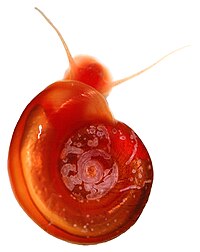
Photo from wikipedia
Fibrinogen-related proteins (FREPs) that contain only the fibrinogen-related domain are likely involved in pathogen recognition. In this study, we identified two FREPs from the razor clam (Sinonovacula constricta), called ScFREP-1… Click to show full abstract
Fibrinogen-related proteins (FREPs) that contain only the fibrinogen-related domain are likely involved in pathogen recognition. In this study, we identified two FREPs from the razor clam (Sinonovacula constricta), called ScFREP-1 and ScFREP-2, and investigated their roles in the immune response. Both ScFREP-1 and ScFREP-2 contained a fibrinogen-related domain at the C-terminal. ScFREP-1 and ScFREP-2 mRNAs were detected in all adult clam tissues tested, with the highest expression levels in the gill and mantle, respectively. Their expression levels were significantly upregulated after microbe infection. Recombinant ScFREPs could bind Gram-positive and Gram-negative bacteria as well as some pathogen-associated molecular patterns (PAMPs), and they could agglutinate those bacteria. These results showed that ScFREPs functioned as potential pattern recognition receptors to mediate immune response by recognizing PAMPs and agglutinating invasive microbes.
Journal Title: Developmental and comparative immunology
Year Published: 2021
Link to full text (if available)
Share on Social Media: Sign Up to like & get
recommendations!